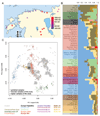The Arrival of Siberian Ancestry Connecting the Eastern Baltic to Uralic Speakers further East
- PMID: 31080083
- PMCID: PMC6544527
- DOI: 10.1016/j.cub.2019.04.026
The Arrival of Siberian Ancestry Connecting the Eastern Baltic to Uralic Speakers further East
Abstract
In this study, we compare the genetic ancestry of individuals from two as yet genetically unstudied cultural traditions in Estonia in the context of available modern and ancient datasets: 15 from the Late Bronze Age stone-cist graves (1200-400 BC) (EstBA) and 6 from the Pre-Roman Iron Age tarand cemeteries (800/500 BC-50 AD) (EstIA). We also included 5 Pre-Roman to Roman Iron Age Ingrian (500 BC-450 AD) (IngIA) and 7 Middle Age Estonian (1200-1600 AD) (EstMA) individuals to build a dataset for studying the demographic history of the northern parts of the Eastern Baltic from the earliest layer of Mesolithic to modern times. Our findings are consistent with EstBA receiving gene flow from regions with strong Western hunter-gatherer (WHG) affinities and EstIA from populations related to modern Siberians. The latter inference is in accordance with Y chromosome (chrY) distributions in present day populations of the Eastern Baltic, as well as patterns of autosomal variation in the majority of the westernmost Uralic speakers [1-5]. This ancestry reached the coasts of the Baltic Sea no later than the mid-first millennium BC; i.e., in the same time window as the diversification of west Uralic (Finnic) languages [6]. Furthermore, phenotypic traits often associated with modern Northern Europeans, like light eyes, hair, and skin, as well as lactose tolerance, can be traced back to the Bronze Age in the Eastern Baltic. VIDEO ABSTRACT.
Keywords: Bronze Age; Eastern Baltic; Estonia; Iron Age; Middle Ages; ancient DNA; kinship; phenotype; population genetics; shotgun sequencing.
Copyright © 2019 Elsevier Ltd. All rights reserved.
Conflict of interest statement
The authors declare no competing financial interests.
Figures



Similar articles
-
Patterns of genetic connectedness between modern and medieval Estonian genomes reveal the origins of a major ancestry component of the Finnish population.Am J Hum Genet. 2021 Sep 2;108(9):1792-1806. doi: 10.1016/j.ajhg.2021.07.012. Epub 2021 Aug 18. Am J Hum Genet. 2021. PMID: 34411538 Free PMC article.
-
Extensive Farming in Estonia Started through a Sex-Biased Migration from the Steppe.Curr Biol. 2017 Jul 24;27(14):2185-2193.e6. doi: 10.1016/j.cub.2017.06.022. Epub 2017 Jul 14. Curr Biol. 2017. PMID: 28712569
-
Between Lake Baikal and the Baltic Sea: genomic history of the gateway to Europe.BMC Genet. 2017 Dec 28;18(Suppl 1):110. doi: 10.1186/s12863-017-0578-3. BMC Genet. 2017. PMID: 29297395 Free PMC article.
-
Human evolutionary history in Eastern Eurasia using insights from ancient DNA.Curr Opin Genet Dev. 2020 Jun;62:78-84. doi: 10.1016/j.gde.2020.06.009. Epub 2020 Jul 17. Curr Opin Genet Dev. 2020. PMID: 32688244 Review.
-
Latest trends in archaeogenetic research of west Eurasians.Curr Opin Genet Dev. 2020 Jun;62:36-43. doi: 10.1016/j.gde.2020.05.021. Epub 2020 Jun 28. Curr Opin Genet Dev. 2020. PMID: 32610222 Review.
Cited by
-
Reconstructing the Genetic Relationship between Ancient and Present-Day Siberian Populations.Genome Biol Evol. 2024 Apr 2;16(4):evae063. doi: 10.1093/gbe/evae063. Genome Biol Evol. 2024. PMID: 38526010 Free PMC article.
-
The Allen Ancient DNA Resource (AADR) a curated compendium of ancient human genomes.Sci Data. 2024 Feb 10;11(1):182. doi: 10.1038/s41597-024-03031-7. Sci Data. 2024. PMID: 38341426 Free PMC article.
-
Stable population structure in Europe since the Iron Age, despite high mobility.Elife. 2024 Jan 30;13:e79714. doi: 10.7554/eLife.79714. Elife. 2024. PMID: 38288729 Free PMC article.
-
A genetic history of the Balkans from Roman frontier to Slavic migrations.Cell. 2023 Dec 7;186(25):5472-5485.e9. doi: 10.1016/j.cell.2023.10.018. Cell. 2023. PMID: 38065079 Free PMC article.
-
Munda languages are father tongues, but Japanese and Korean are not.Evol Hum Sci. 2020 May 29;2:e19. doi: 10.1017/ehs.2020.14. eCollection 2020. Evol Hum Sci. 2020. PMID: 37588351 Free PMC article. Review.
References
-
- Pliss L, Tambets K, Loogväli E-L, Pronina N, Lazdins M, Krumina A, Baumanis V, Villems R. Mitochondrial DNA portrait of Latvians: towards the understanding of the genetic structure of Baltic-speaking populations. Ann Hum Genet. 2006;70:439–458. - PubMed
-
- Rootsi S, Zhivotovsky LA, Baldovic M, Kayser M, Kutuev IA, Khusainova R, Bermisheva MA, Gubina M, Fedorova SA, Ilumäe A-M, et al. A counter-clockwise northern route of the Y-chromosome haplogroup N from Southeast Asia towards Europe. Eur J Hum Genet EJHG. 2007;15:204–211. - PubMed
Publication types
MeSH terms
Substances
Grants and funding
LinkOut - more resources
Full Text Sources
